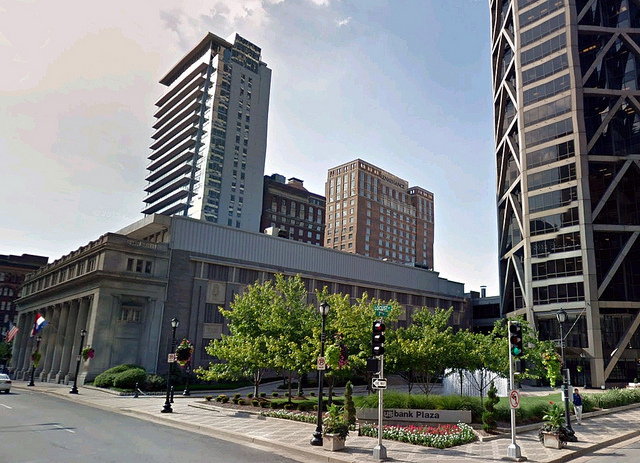
From the U.S. Bank website:
A new outdoor plaza was created in the late 1990's, providing a facelift for the building's south entrance and the connecting Eighth Street Bank Building. The landscaped plaza presents downtown with an inviting, park-like atmosphere and links the historic Eighth Street Bank with the adjacent high-rise. The plaza provides a natural meeting area where numerous building events are held. The plaza also features a lush elevated lawn and its centerpiece, a large cylinder-shaped fountain with twelve-foot jets of water. The fountain is visible from the street through a grove of red maple trees that provide shade and gorgeous fall color.
In the north plaza, planters were built around existing Hawthorne trees. The Plaza's signature stainless steel sculpture, Synergism, reflects the colors of an abundance of flowers planted around its base. Interlocking pavers and traditional lampposts were used around the entire city block and provide a sense of unity, history, and tradition to U.S. Bank Plaza.
It's relatively easy to make an urban plaza sound like a wonderful amenity, something that adds to the downtown environment, a "natural meeting area", a "lush" lawn, a grove of red maple trees providing shade and color… and on and on. What isn't mentioned is what preceeded the urban plaza. Downtown St. Louis has many. In fact, the Central Business District has just five urban intersections left. The way we talk about cities and recognize urban, economically sustainable development needs to change. Not every building needs a plaza with shade trees. Buildings need other buildings.
So what was there before? Oh, just this (demolished in 1996):






{image from Paul Hohmann – Vanishing STL}

{image from Built St. Louis}

{image from Paul Hohmann – Vanishing STL}

{image from Paul Hohmann – Vanishing STL}
Check out more images and the story of the Ambassador's demolition at Vanishing STL and more on the theatre's Wikipedia page.

